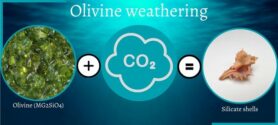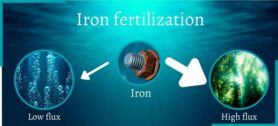Oceans and CO2
Breathing oceans; to be hopeful about climate change
You hear it all the time in the news; climate change is getting worse, we have to act now! Sea level is rising, temperature is warming, what do we do?! The new IPCC report that recently came out again shows we are not doing enough to reduce the effects of climate change. What if I told you there are many new innovative ways to deal with the rising levels of atmospheric CO2 and that it’s not all hopeless? Oh yes, it’s true, there are ways to combat climate change on a larger scale. It all involves the oceans. Researchers found out different ways to extract CO2 from the atmosphere and store it into the oceans. This article will show you two of the innovations we can use to solve the current climate crisis.
One interesting way of combating the climate problem, and the first innovation I would like to share, has been thought of by researcher Tom Green, a British biologist and the director of the charity Project Vesta. He states that he can turn CO2 into rock by putting a special kind of sand into the ocean. This sand is made of ground-up olivine, which is a type of mineral formed deep in the Earth’s core. Olivine is quite an unstable mineral at earth’s surface, and will degrade into silicate minerals easily in a process called weathering. Olivine uses CO2 in the water to do so, which causes the concentration of CO2 in the ocean to drop. The silicate is then used by some animals in the ocean to create their shell.

But wait, wasn’t it atmospheric CO2 that was the problem? The whole greenhouse effect and all that? Very much so, yes. So why is it that dropping CO2 concentrations in the ocean can have a huge effect on climate change? It’s all in the natural balance of CO2 concentrations in the ocean and in the atmosphere. The atmosphere and ocean are in constant contact with each other and exchange gasses such as CO2 in a perfect balance. If CO2 is taken out of concentration in the ocean by say, olivine, more room is created for atmospheric CO2 to move into the ocean. Therefore, CO2 is drawn from the atmosphere and the greenhouse effect becomes weaker.
Secondly, a similar mechanism was used to create yet another method to remove CO2 from the atmosphere. The ocean contains many organisms, such as large animals and fish, but also plankton. Plankton consists of plant material, which means it can do photosynthesis. Photosynthesis is the process in which plants use CO2 and water and convert that into glucose and oxygen to grow. Plankton does not only need CO2 and water, it also needs some nutrients and other elements in very small amounts. Usually, these nutrients are the limiting factors of growth for plankton as it is not readily available in our huge oceans.
This sounds like an easy fix, we add nutrients to the ocean so that plankton grows and pulls CO2 into the ocean. This is a controversial idea which has been provided by David King, who is a scientist at the Centre for Climate repair. He is going to test this principle by adding iron into the ocean in controlled trial studies. Iron is one of the limiting nutrients and so-called ‘iron fertilization’ could provide an extra input for CO2 into the oceans and away from the atmosphere. His theory is supported by researchers such as David Emerson from the Bigelow Laboratory for Ocean Sciences in the USA.

However, there are some concerns regarding this method. Researchers such as Robert Jackson (director of Duke University’s Center of Global Change) fear iron fertilization will disturb the natural balance in the ocean. He states it is dangerous to play with Earth’s climate. By creating a bloom of plankton, CO2 is used for growth. The plankton will eventually die and slowly move downwards into the deeper oceans. This dead plant matter will degrade, using oxygen again and providing CO2. When oxygen is used in the deep ocean, it is not easily replenished and the oxygen levels drop. Other animals need oxygen to live, so large portions of the ocean will become uninhabitable if plankton blooms become too intense. If monitored well and done correctly, iron fertilization could be a promising method.
Sadly, these two solutions are not enough to combat climate change. One thing we know for sure, we have to act. The role CO2 plays in climate change is undisputed and we have to try and limit the effect. Prof. Dr. S. Drijfhout is a researcher who worked on the IPCC report that recently came out. He states that the best we could do as individuals is to work on meeting the Paris agreement requirements by consuming less energy and use less transportation. ‘One of the biggest differences we could make as individual humans is to cut our travel movements and invest in small local sustainable initiatives to initiate change’. If we can shift our mindset to a place where eternal growth isn’t the main goal, we still have a chance to limit the effects of climate change.
Prof. Dr. S. Drijfhout also sees a future in sustainable housing projects; ‘If I had the money and opportunity to do so, I would invest in sustainable initiatives regarding small community housing projects, as to make a small change that could form a snowball effect to a more sustainable world’. He firmly believes a good example will make others follow. Hope can be found, even in the darkest of times, if only one knows how to turn on the light. That light can, in my opinion, be found in ourselves, and in the innovations we all invent every day. The solutions I showed you are already put to use, so stay hopeful!
Tika van Galen

